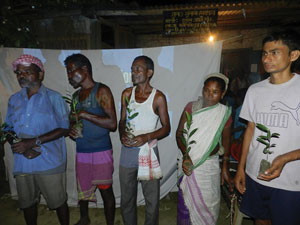Archives
Candid Conservationists
Despite the escalating man-wildlife conflict or the ongoing violation of wildlife ethics by many, a village in the periphery of Burhapahar Range in Kaziranga National Park, Assam has set an example for the rest of mankind in the conservation history of Assam. At a time when man-animal conflict and rhino poaching is hitting the headlines and most people are not comfortable with large carnivores like tigers around their villages, the news of the birth of four tiger cubs had showcased a new-fangled outlook of the villagers in Natundanga Gaon. They left no stone unturned to ensure the safe upbringing of these cubs.
Natundanga Gaon is a tribal hamlet located on the fringes of Kukurakata Reserved Forest near Panijuri forest camp of Burapahar Range of the Park. As he does every day, Gandhi Singer, a villager went to the Panijuri stream to graze his cows and returned with a suspicion of the presence of a carnivore in the area. “For around 2-3 days, we marked a sequential death of deer in the jungle area neighbouring our village and tried to find the reason. One fine day, a villager discovered four newly-born tiger cubs along with their mother and informed us,” Mangal added. “I still feel glad recalling the day when the entire village was cherishing the news of the newborns. I noticed a new and sanguine perspective on the situation,” Mangal says with a smile.
With a group of boys leading them, the entire hamlet geared up to take the conservation initiative with the help of the forest department. “All the villagers were asked to stop using the stream side route for any purpose. Cattle grazing was completely prohibited in that area so that the cubs are in no way distracted,” Ajay Teron, a member of the group says. Days passed and no villager went to the stream, which was also a source of water for them. They kept updating the forest department about the new guests and tried not to violate the wildlife ethics. Gradually, after a month, it was noticed that the mother and cubs no longer inhabited in that location and the villagers heaved a sigh of contentment. However, this was not the end of their efforts.
of the forest department. “All the villagers were asked to stop using the stream side route for any purpose. Cattle grazing was completely prohibited in that area so that the cubs are in no way distracted,” Ajay Teron, a member of the group says. Days passed and no villager went to the stream, which was also a source of water for them. They kept updating the forest department about the new guests and tried not to violate the wildlife ethics. Gradually, after a month, it was noticed that the mother and cubs no longer inhabited in that location and the villagers heaved a sigh of contentment. However, this was not the end of their efforts.
Today, they are busy with various conservation activities and supporting the protection of their very own national park in many ways.
Even during the time of floods when a large number of the wildlife of Kaziranga drowns even as many are knocked-down by the vehicles while escaping to the highlands besides the many killed by villagers; this village since 2010 has been acting as a helping hand in mitigating the plight of these wild animals. “Since the day we learned how to rescue a wild animal during flood, we have rescued several animals in our area. Regular awareness programmes by Aaranyak has generated interest amongst us and we have been taught the process of rescuing a wild animal,” Jay Singh Teron, a villager says.
Pohu (deer) and bonoriya gahori (wild boar) meat is a monsoon delicacy in these parts of Assam and locals happily make a meal of animals edged out by floods. Even roadkill is often used in the kitchen. Not to forget, hunting is also customary to the tribes. “Yes, hunting has been a sport among the villagers and every Sunday (before 2010), villagers from almost each household rushed for hunting inside the forest. It was like an age-old time table followed and indulged in by all,” says Mangal. There was no distinct species of fauna that was targeted by the hunters. Some were killed for mere joy while many were brought down for meat. The ways and ends of these practices differed according to the needs of bringing the animal down. “However, today we can proudly claim that hunting practices no longer prevail in our village. This change was marked gradually right after the awareness campaigns conducted by Aaranyak in our locality,” Mangal says.
Besides this, in spite of having no electricity, proper transportation, clean water etc, these villagers have been consistently contributing towards anti-poaching activities and conservation of wildlife, supporting the forest staff even during night patrolling. “Our village conducted a cycle rally last year protesting against the frequent rhino poaching. A street play highlighting the issues of conservation was also enacted by the participants. Not only this, a plantation programme was also conducted by a group of 11 boys in 3-4 schools in KNP on the occasion of ‘World Tree Day’ last year,” Ajay Teron, a member, Eco-Development Committee explains.
Such gestures of the villagers are commendable and rare while a section of villagers around the park are protesting the declaration of Kaziranga as a Tiger Reserve (notified in 2007) since 2010. Differences between the villagers and the forest department have grown since then. Nevertheless, no hurdle did dishearten the admirable village and they promise to continue with their endeavour.

